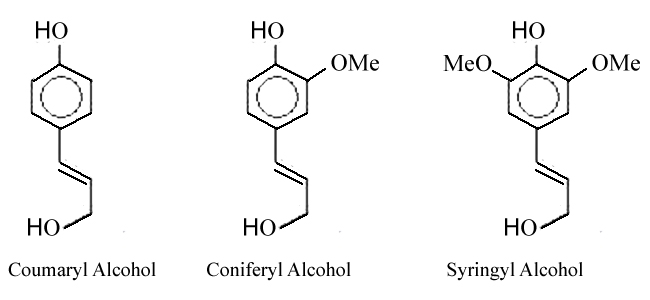Lignin is an aromatic complex polymer of monolignols (aromatic alcohols) which is found in plant cell walls. Later than cellulose, lignin is the most abundant natural polymer in the planet. It is not composed of carbohydrate monomers whereas the rest of polymers found in plant cell walls are composed of carbohydrate monomers for example cellulose. In wood, it contains about 17-32% of the weight of moisture free wood depends on the species, age of wood etc; such as in soft wood average 28%, whereas 24% in hardwood. Moreover, it is not equally distributed throughout the same wood; different parts may content different percentages.
Due to highly complex chemical nature, the lignin structure is still unknown and there are few physical and chemical properties of lignin are known. Still the isolation of it’s unachievable. All the properties of lignin are determined depends on its derivatives. Nearly all of the lignin in plants is insoluble in inert solvents. The lignin structure is amorphous and the color is dark brown.
Lignin structure is not unique; depending on the species, lignin structure is composed of up to three different phenyl propane monomers such as coniferyl alcohol, syringyl alcohol and coumaryl alcohol units; coniferyl alcohol dominant in softwoods, syringyl in hardwoods and coumaryl alcohol in grasses and agricultural crops. These individual units can be composed in various probable bonding patterns. The shape is not linear whereas cellulose is linear; it is highly branched or cross-linked polymer. The molecule of it contains many reactive functional groups as like phenol propane unit, hydroxyl groups, methoxyl groups, carbonyl groups etc. These groups exhibit their characteristic reactions in suitable conditions.

The lignin plays many significant biological roles in plants; the various function of lignin is:
- It is responsible for providing construction of plants as like grasses, bushes and rigid trees. In contrast, some mosses don’t contain any lignin at all.
- The lignin in plants is less hydrophilic compare to cellulose and hemicelluloses; hence it prevents the absorption of water.
- The lignin in plants also works as a barrier against attack by insects and fungi.
- It transports liquids all over the plant tissues.
Commercial uses of Lignin: It can be utilized in many industries such as pulp & paper, agriculture and construction. Some uses of Lignin are described in below:
- In sulfite pulping process lignosulfonates is an important byproduct; it contains sulfonate (-SO3-) groups, therefore it is soluble in water. lignosulfonates can be used as dispersants, binders, complexing agents and emulsifying agents.
- It can be used as alternative raw materials for plastics.
- Lignin in plants also burns very effectively, It can be used as bio-based alternative to petroleum.
- The other uses of Lignin are animal feed, coatings, agricultural chemicals, micronutrients, natural binders, adhesives, resins, and in the manufacturing of vanillin and textile dyes.
Very good article. Clearly explain about the lignin.
I agree with gunasekar, it is a nice clear article about lignin.
In many of my courses i introduce lignin as follows. I tell my students that millions of years ago, when all the trees fell down, the bugs ate all the cellulose, and left the lignin. Time, temperature and pressure eventually turned the lignin into coal.
In terms of papermaking, I tell them to think of lignin rather like a hot melt adhesive. When it is at room temperature it is hard, brittle and water repellent. As it gets hotter it starts to soften. This is the key to mechanical pulping. The warmer the lignin, the softer it becomes and the more easily the fibres are removed without damage. But too much heat will cause the lignin to flow like a liquid. This action will cause the lignin to coat the whole surface of the fibre, and so when it cools, the fibres will be more like needles of glass, with no cellulosic surface available for bonding.
Thanks, Dr Steven Mann and gunasekar for your comments
Thanks for valuable information.
We would like to get the costs of lignin.
Under STP conditions is lignin solid, liquid or gaseous?
Excellent article on lignin. Thank you. It does appear there is much more we can learn about lignin though. Keep at it.